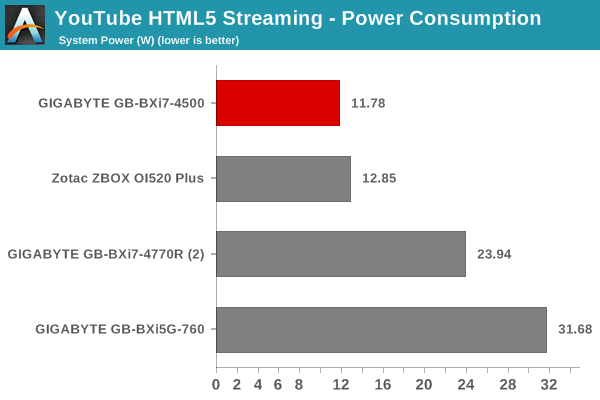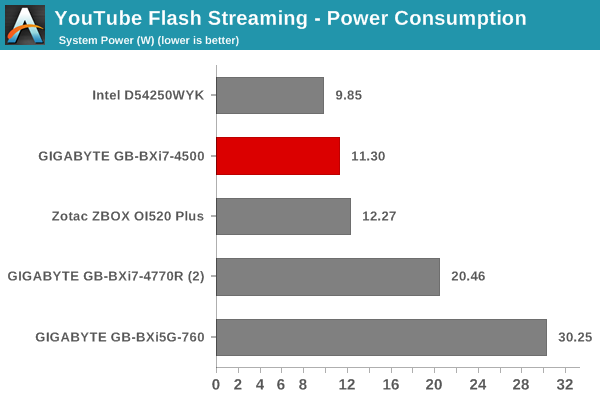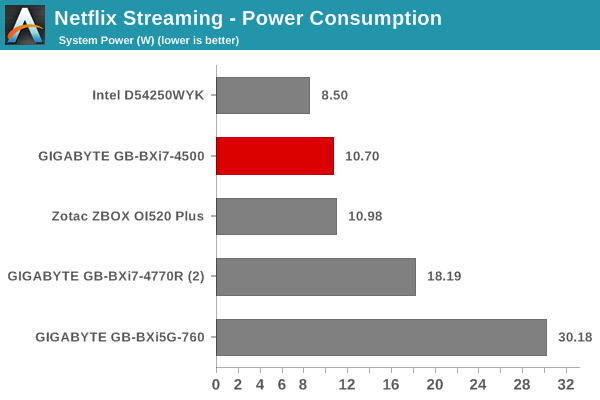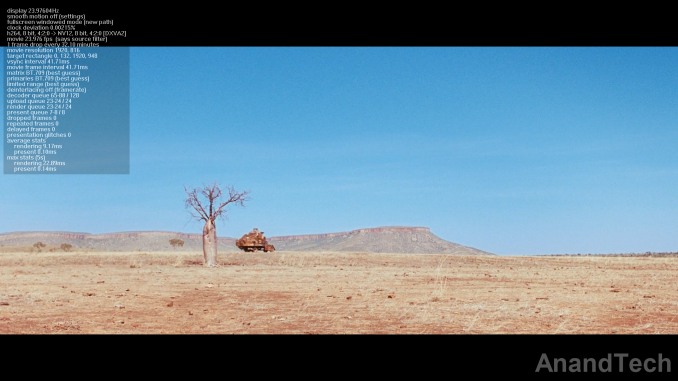GIGABYTE BRIX GB-BXi7-4500 Review: Intel Core i7 in a UCFF PC
by Ganesh T S on October 9, 2014 7:00 AM ESTHTPC Credentials
The GIGABYTE GB-BXi7-4500U is a compact PC, but, thanks to the 15W TDP CPU inside, it doesn't require a noisy thermal solution like what we saw in the BRIX Pro and BRIX Gaming units. With the latest BIOS version, the fan curves have been improved and the unit is silent for most common HTPC use-cases. Only under heavy CPU / GPU loading does the fan become audible. From a subjective viewpoint, one could say that it has worse acoustics compared to the Intel NUC kit (probably due to differences in the chassis materials and thickness). However, as mentioned before, it still makes a good HTPC for folks who don't want to pay the premium for a passively cooled system.
Refresh Rate Accurancy
AMD and NVIDIA have historically been able to provide fine-grained control over display refresh rates. The default rates are also quite accurate. Intel used to have an issue with 23 Hz (23.976 Hz, to be more accurate) support, but that was resolved with the introduction of Haswell. As expected, the GIGABYTE GB-BXi7-4500 has no trouble with refreshing the display appropriately in the 23 Hz setting.
The gallery below presents some of the other refresh rates that we tested out. The first statistic in madVR's OSD indicates the display refresh rate.
Network Streaming Efficiency
Evaluation of OTT playback efficiency was done by playing back our standard YouTube test stream and five minutes from our standard Netflix test title. Using HTML5, the YouTube stream plays back a 720p encoding, while Adobe Flash delivers a 1080p stream. Note that only NVIDIA exposes GPU and VPU loads separately. Both Intel and AMD bundle the decoder load along with the GPU load. The following two graphs show the power consumption at the wall for playback of the HTML5 stream and the Adobe Flash stream in Mozilla Firefox v32.0.1. The i5-equipped Intel NUC is obviously more power efficient thanks to its lower clocks. The GPU is hardly stressed enough for the higher clocks to make a difference. For the HTML5 streaming case, GPU-Z reported an average utlization rate of 16.85% over the course of playback. The reuivalent for the Adobe Flash streaming case was only 8.3%. The increased loading in the former case could be due to the need to scale the 720p video for display on a 1080p screen.


Netflix streaming evaluation was done using the Windows 8.1 Netflix app. Manual stream selection is available (Ctrl-Alt-Shift-S) and debug information / statistics can also be viewed (Ctrl-Alt-Shift-D). Statistics collected for the YouTube streaming experiment were also collected here. The GPU loading for the Netflix streaming case was quite interesting to observe. For non-SuperHD bitrates (such as the 1750 kbps 480p version), the utilization varied between 7.38% and 9.72%. However, once the 5.8 Mbps 1080p stream took over, the loading reduced to 3.22% (indicating that scaling the decoded video was the factor keeping the GPU busy).

Decoding and Rendering Benchmarks
In order to evaluate local file playback, we concentrate on EVR-CP and madVR. We already know that EVR works quite well even with the Intel IGP for our test streams. We tested out native DXVA2 decoding with EVR-CP. Under madVR, we used the default scaling options as well as DXVA2 scaling logic (as it is well known that the stressful configurations don't work even on the Iris Pro-equipped processors). The decoder used was LAV Filters bundled with MPC-HC v1.7.7
| GIGABYTE GB-BXi7-4500 - Decoding & Rendering Performance | ||||||||
| Stream | EVR-CP | madVR - Default | madVR - DXVA Scaling | |||||
| GPU Load (%) | Power (W) | GPU Load (%) | Power (W) | GPU Load (%) | Power (W) | |||
| 480i60 MPEG2 | 22.83 | 12.73 | 73.26 | 18.65 | 54.41 | 16.78 | ||
| 576i50 H264 | 20.47 | 12.43 | 68.87 | 20.62 | 56.07 | 17.03 | ||
| 720p60 H264 | 27.12 | 14.14 | 73.07 | 27.51 | 63.80 | 19.30 | ||
| 1080i60 MPEG2 | 29.36 | 14.94 | 49.21 | 20.94 | 71.32 | 29.15 | ||
| 1080i60 H264 | 30.50 | 15.34 | 46.83 | 22.94 | 70.16 | 29.44 | ||
| 1080i60 VC1 | 29.69 | 15.10 | 48.77 | 21.09 | 69.80 | 29.48 | ||
| 1080p60 H264 | 31.01 | 15.32 | 70.12 | 26.36 | 68.44 | 29.37 | ||
| 1080p24 H264 | 12.41 | 12.31 | 25.03 | 13.86 | 29.17 | 15.04 | ||
| 4Kp30 H264 | 28.78 | 16.08 | 47.55 | 30.89 | 69.03 | 35.31 | ||
Entries in bold in the above table indicate failure to playback the stream at the required frame rate with the corresponding post processing options. The GB-BXi7-4500U is not a madVR machine for high frame rate materials, but, for odinary Blu-rays (1080p24), it is more than capable.

















27 Comments
View All Comments
Shadowmaster625 - Thursday, October 9, 2014 - link
$750!!! haha. Pass it over here, man. May as well just buy a surface pro. Its not like this is a real i7 anyway. It is just an underclocked desktop i3 that occasionally runs at near stock clocks. And for that they charge $750!!!!Flunk - Thursday, October 9, 2014 - link
To get an equivalent processor in a Surface Pro 3 it would cost you $1,599.00, so I don't know what you're thinking of there.This is the same story as it always is with small form factor systems. You're paying for the size. The NUC form factor is small enough to attach to a VESA bracket. To get to that size they need to use Ultrabook components. If you want cheap pick up an AMD AM1 chip and mini-itx board or one of the little Baytrail Celeron-based mini-itx boards.
johnny_boy - Thursday, October 16, 2014 - link
You don't need ultrabook components for a vesa mountable pc. A number of mITX cases have them. And they use full sized components like ram and hardisks. The problem with todays mITX standard is that there is no appropriate small psu standard to match. SFX is till too big and pico psus require (always?) external bricks.dakishimesan - Thursday, October 9, 2014 - link
I love small ff pcs, but the mac mini is available for 599 with 2.5GHz dual-core Intel Core i5 (Turbo Boost up to 3.1GHz) with 3MB L3 cache, or 799 with 2.3GHz quad-core Intel Core i7 (Turbo Boost up to 3.3GHz) with 6MB L3 cache -- 35w cpus in a close size.WithoutWeakness - Thursday, October 9, 2014 - link
Mac Mini is considerably larger/heavier and can't be VESA mounted without dropping $50+ on an adapter. It certainly is a very capable machine for its size and the more powerful CPU options blow past the NUC-class devices but NUC, BRIX, and similar devices do a good job filling a niche for super-small "powerful-enough" x86 devices. I have the i5 Haswell NUC for a media center box and it's great for everything from media playback to some casual 1080p couch gaming and it's hardly bigger than my Raspberry Pi.MrCommunistGen - Thursday, October 9, 2014 - link
Also, despite the raw performance of the Mac Mini compared to dual core NUC-like devices, the Mac Mini uses IVB CPUs and come with 5400 RPM HDDs standard. I can see the former being an obstacle to some of the HTPC crowd. For the latter... I simply demand SSDs in any computer I spend any time using.dakishimesan - Thursday, October 9, 2014 - link
Yes true. I am a Mac Mini enthusiast but it is really annoying that Apple sometimes is right at the edge of new CPUs and other times is years behind. I bought the Sandy Bridge Mac Mini, the last one with the discrete GPU, when they released it about four months after Sandy Bridge became available. Interestingly, it was also one of the first computers available thunderbolt. The next year they upgraded to IVB almost immediately, but drop the discrete GPU, and this year there has been an update at all… So yes that sucks. I won't upgrading again until they get updated processors. However, one thing Apple loves is big increases in efficiency, so I would be surprised if they don't release a Broadwell Mac Mini, hopefully with an Iris pro Intel chip.And yes, the first thing I did was bust open my Mac Mini and put in a Samsung 840 pro SSD in there. But it wasn't the easiest upgrade of ever done.
Haravikk - Thursday, October 9, 2014 - link
Actually if you have a good electric drill you can easily VESA mount a Mac Mini; it's base is only plastic, you just drill the four holes in a 100mm square's corners, screw it into the back of the monitor/TV, place the Mac Mini onto the cover and twist it into position. With proper cable management the mini won't move at all once you've bound the power and video cables together plus, the power button is pressed in the locked direction, so there's no risk there.Of course, Apple won't repair your mini for you if there are holes in the cover, but you can get a spare for $25 or so if you need one. I've done this for a Mac Mini that's used quite a lot; it runs no hotter than when it just sitting on a desk. If Apple gets around to updating the Mac Mini with newer, more efficient processor options then it would be even better.
I'm currently building my own VESA mountable machine (or will be, if the processor ever arrives) with an Akasa Euler case and an i7-4790T (quad core, hyper threaded, 2.7ghz with 3.9ghz turbo boost and HD 4600 graphics). It ought to be pretty sweet; admittedly it touches £750 but that's with a 500gb mSATA SSD, 16gb RAM and that processor is overkill for most use-cases, so I could easily drop it into the $750 range with more modest components, while still trouncing the system in this article.
dakishimesan - Thursday, October 9, 2014 - link
That's a really interesting case, thanks for the heads up.Pugwash - Saturday, December 20, 2014 - link
Nice setup. What motherboard did you use?